Online thrift stores are becoming more and more popular for sustainable shopping. They offer a way to purchase high-quality, gently-used items at affordable prices while reducing waste and the environmental impact of manufacturing new goods.
Thrift stores are also a great way to support charitable organizations and small businesses.
In this blog post, we will explore the benefits of online thrift stores, how they work, and provide some tips for sustainable shopping.
Benefits of Online Thrift Stores
Online thrift stores provide several advantages to both consumers and the environment:
1. Wide Selection and Accessibility: Online thrift stores often carry a much larger selection than physical stores, as they source items from various locations. This allows consumers to find unique items that may not be available locally.
2. Affordable Prices: Since online thrift stores don’t face the overhead costs of brick-and-mortar stores, such as rent and utilities, they can offer items at lower prices. Shoppers can find high-quality clothing and accessories for a fraction of the retail cost.
3. Convenience: Shopping from home offers convenience, allowing consumers to browse thousands of items without leaving their residence. Online platforms enable users to search for specific items, making it easier to find exactly what they need.
4. Environmental Impact: By purchasing second-hand goods, consumers help reduce the demand for new products, conserving resources and lowering carbon emissions associated with manufacturing. It also keeps items out of landfills, contributing to waste reduction.
How Online Thrift Stores Work
Online thrift stores operate similarly to traditional thrift shops, but with a few key differences:
- Sourcing: Items are collected from donors or consignment sellers from various locations, giving online stores access to a larger inventory.
- Quality Control: Online thrift stores often implement stringent quality checks, inspecting each item for defects and wear before listing them for sale.
- User-Friendly Platforms: Most online thrift stores have streamlined platforms where consumers can browse, search, and filter through categories based on size, brand, and condition.
Tips for Sustainable Shopping at Online Thrift Stores
- Research Policies: Before making a purchase, check the store’s shipping costs, return policies, and sustainability practices.
- Inspect Product Listings: Carefully review product descriptions and photos to ensure the item’s quality meets your expectations.
- Know Your Measurements: Make sure you’re aware of your size or the measurements of the items you’re buying to avoid returns, which can contribute to environmental waste.
- Patience is Key: The perfect item may take some time to find, so revisit the site regularly for new arrivals.
- Consider the Environmental Impact: Focus on purchasing items made from sustainable materials or that require minimal resources to recycle or reuse.
Online Thrift Store for Sustainable Shopping
ThredUP
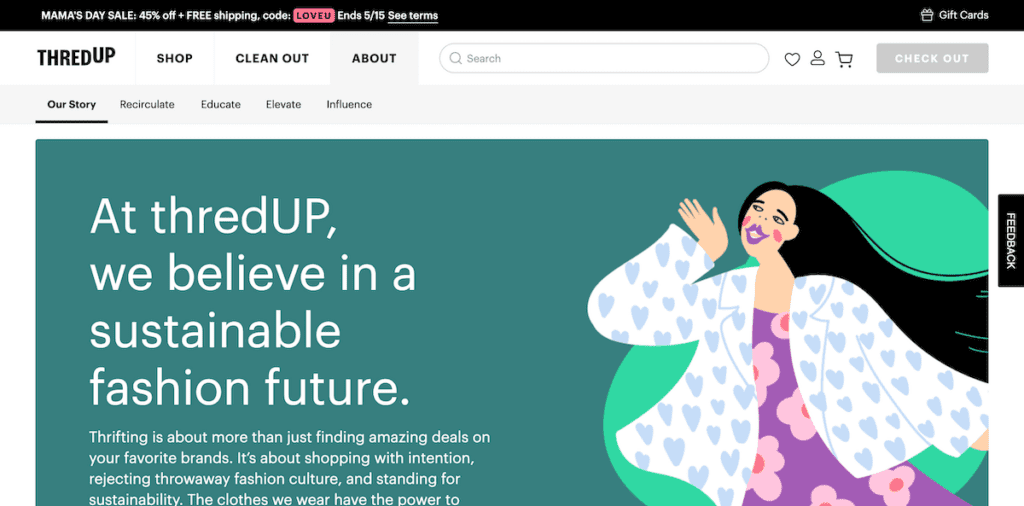
ThredUP is a leading online thrift store that offers a wide range of secondhand clothing, shoes, and accessories for women, men, and children. With a user-friendly interface, ThredUP provides affordable, pre-owned items from popular brands, carefully inspecting each piece to ensure quality.
Customers can also sell their gently used clothing through ThredUP’s “Clean Out” service, earning a percentage of the proceeds. Committed to sustainability, ThredUP promotes the circular economy by extending the life of garments, reducing fashion waste, and fostering a community where users can share and explore each other's collections.
Curtsy
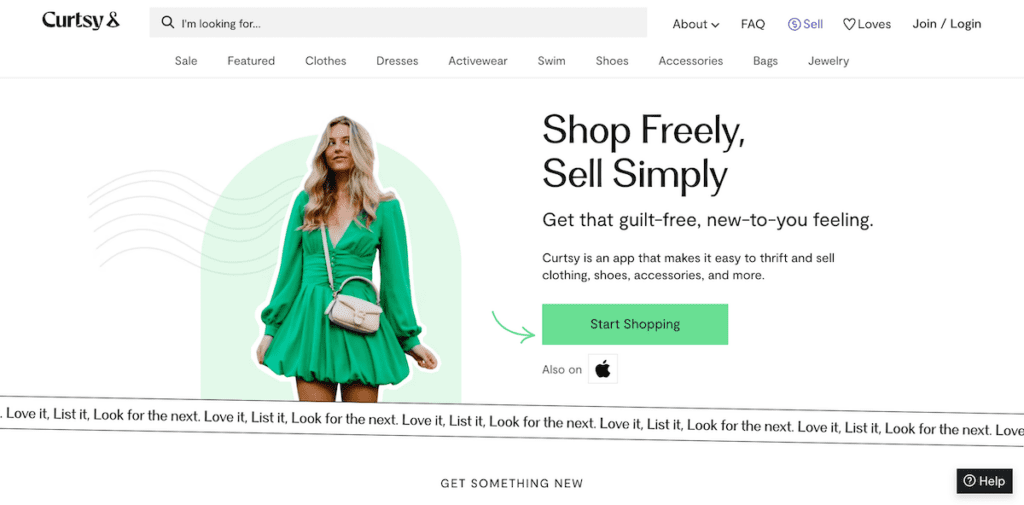
Curtsy is a mobile app-based platform that facilitates buying and selling of women’s clothing and accessories.
Designed with a focus on college campuses, Curtsy offers a convenient way for individuals to refresh their wardrobes sustainably and earn money by selling their gently used items.
With the Curtsy app, users can browse through a diverse range of pre-owned clothing, shoes, and accessories.
The platform emphasizes trendy and fashionable styles, catering to the preferences of its target audience.
Users can filter their search based on categories, sizes, brands, and even specific college campuses to find items that match their personal style.
Selling on Curtsy is made simple and user-friendly. Sellers can create listings by uploading photos of their items, adding descriptions, setting prices, and selecting shipping preferences.
Curtsy also provides pre-paid shipping labels to streamline the shipping process, making it easy for sellers to send their sold items to buyers.
The app incorporates social elements, allowing users to follow each other, like and comment on listings, and create their own curated collections of favorite items.
This fosters a sense of community and enables users to discover new styles and connect with like-minded individuals.
Curtsy prioritizes safety and trust within its community. It implements a rating and review system, encouraging users to provide feedback on their buying and selling experiences.
This helps establish a reliable reputation for sellers and promotes a secure environment for transactions.
Poshmark
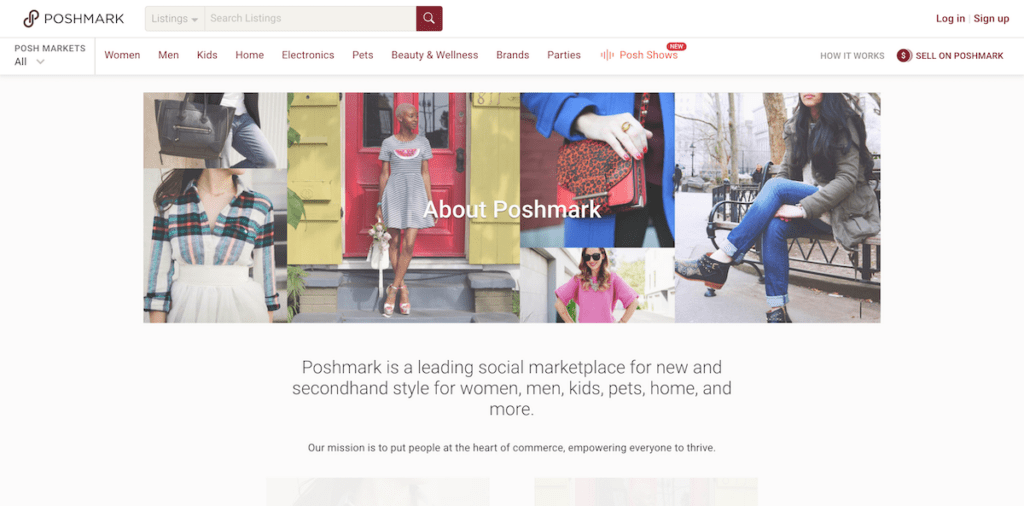
Poshmark is a popular online marketplace that enables individuals to buy and sell pre-owned clothing, accessories, shoes, and more.
The website and mobile app provide a convenient platform for fashion enthusiasts to refresh their wardrobes and engage in a vibrant community of buyers and sellers.
On Poshmark, users can browse through a wide range of items from various brands, including both high-end and affordable options.
The platform offers a diverse selection of styles, catering to different tastes and preferences.
Users can filter their searches based on categories, sizes, brands, and price ranges, making it easy to find desired items.
Selling on Poshmark is easy. Sellers can create listings by uploading photos, providing detailed descriptions, setting prices, and choosing shipping options.
Poshmark also facilitates shipping by providing pre-paid shipping labels, simplifying the process for sellers and buyers alike.
Poshmark’s community-focused approach sets it apart. Users can follow each other, like and comment on listings, and even host virtual Posh Parties where specific themes or brands are highlighted.
Depop
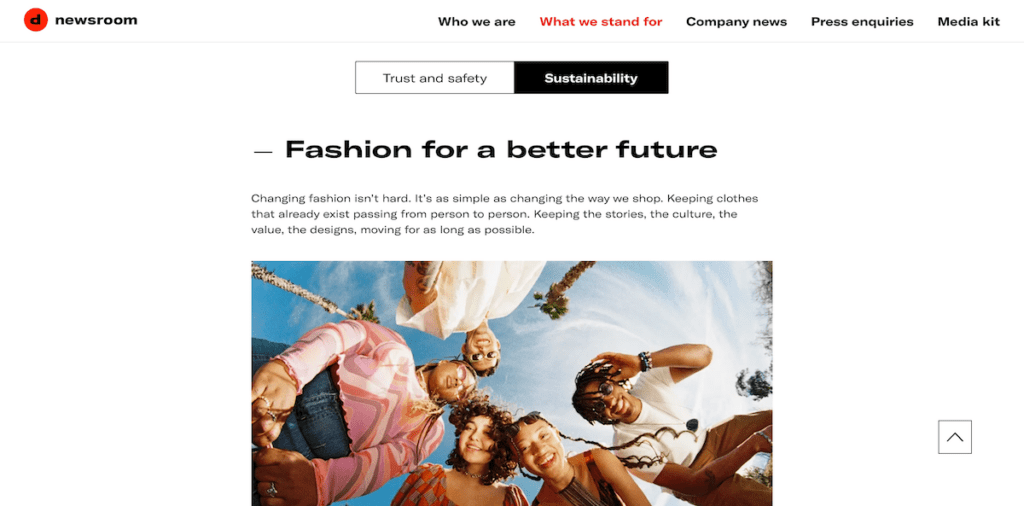
Depop recognizes the negative environmental and social impact of fast fashion and aims to provide an alternative that promotes a circular economy and reduces waste.
They believe that by extending the lifespan of clothing and encouraging the reuse and reselling of items, they can contribute to a more sustainable future.
Depop emphasizes the importance of reducing, reusing, and recycling. They encourage sellers and buyers to participate in their mission by actively engaging in sustainable practices.
By selling pre-owned items on the platform, individuals can extend the lifecycle of clothing and prevent it from ending up in landfills. Likewise, buyers can find unique and stylish items without contributing to the demand for new production.
The platform also emphasizes the value of vintage and secondhand fashion. Depop celebrates the individuality and creativity found in vintage and unique clothing.
By promoting the appreciation and consumption of pre-loved items, they strive to shift consumer behavior towards more sustainable choices.
Depop highlights its efforts to educate its community and raise awareness about sustainable fashion practices.
They share resources, tips, and guides to help users make informed decisions about their purchases and learn more about the environmental impact of the fashion industry.
Additionally, Depop collaborates with various organizations and initiatives to further their sustainability goals. They work with partners to develop innovative solutions and promote responsible practices within the fashion ecosystem.
Swap
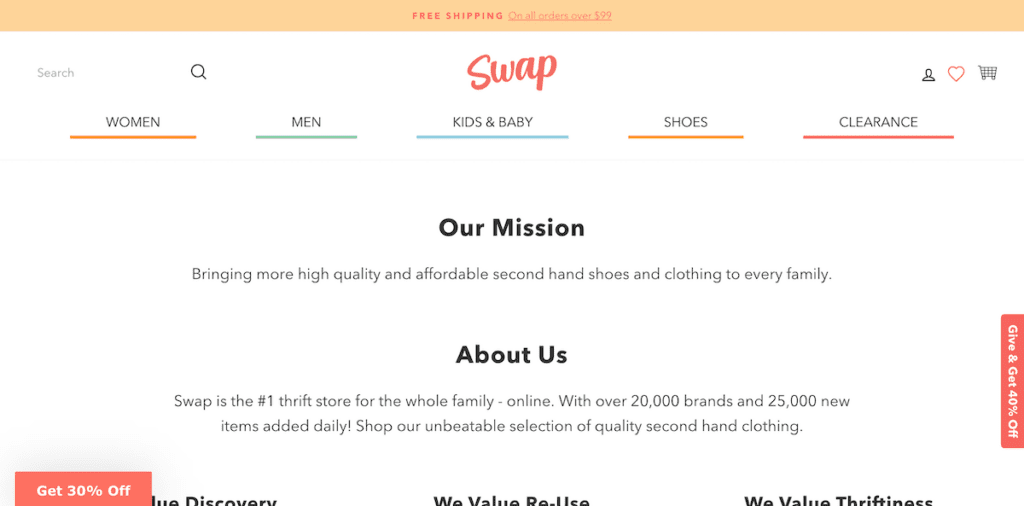
Swap offers a wide selection of items from over 20,000 brands, including women’s, men’s, and children’s clothing, as well as toys, books, and games.
Their search functionality allows customers to easily browse through thousands of items and filter by size, brand, and other preferences.
Sellers can also easily list items for sale, with Swap handling the shipping and customer service aspects of the transaction.
In addition to providing a marketplace for secondhand items, Swap also prioritizes sustainability and responsible business practices.
They promote recycling and waste reduction by providing prepaid shipping labels for unsold items, and any unsold items that are not in sellable condition are donated to charities or recycled.
Swap’s focus on sustainability is also evident in their packaging and shipping practices. They use recycled and recyclable materials for their packaging, and they offer carbon-neutral shipping options to reduce their environmental impact.
Overall, Swap offers a convenient and affordable option for people looking to shop sustainably and reduce waste.
Their focus on responsible business practices and commitment to sustainability make them a reliable choice for those looking to make a positive impact on the environment while also finding great deals on pre-owned items.
Vestiaire Collective
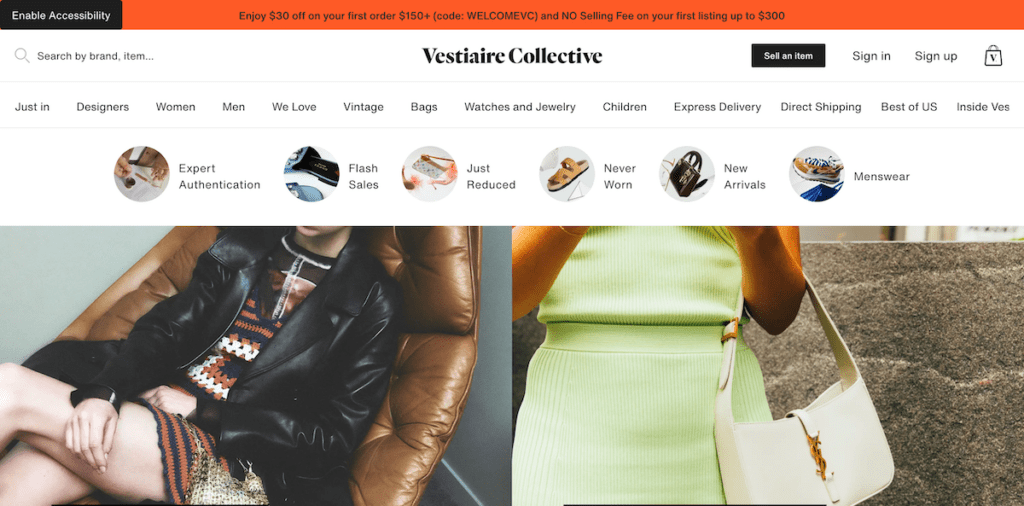
Vestiaire Collective’s Sustainability focuses on creating a circular economy by promoting the reuse and longevity of luxury fashion items. Vestiaire Collective emphasizes conscious consumption, encouraging individuals to invest in timeless pieces and combat fast fashion.
Transparency and traceability are prioritized, with detailed information provided about each item’s origin, authenticity, and condition.
The platform actively collaborates with brands and organizations to drive positive change. Community engagement is also a key aspect, empowering users to contribute to a more sustainable future.
Etsy
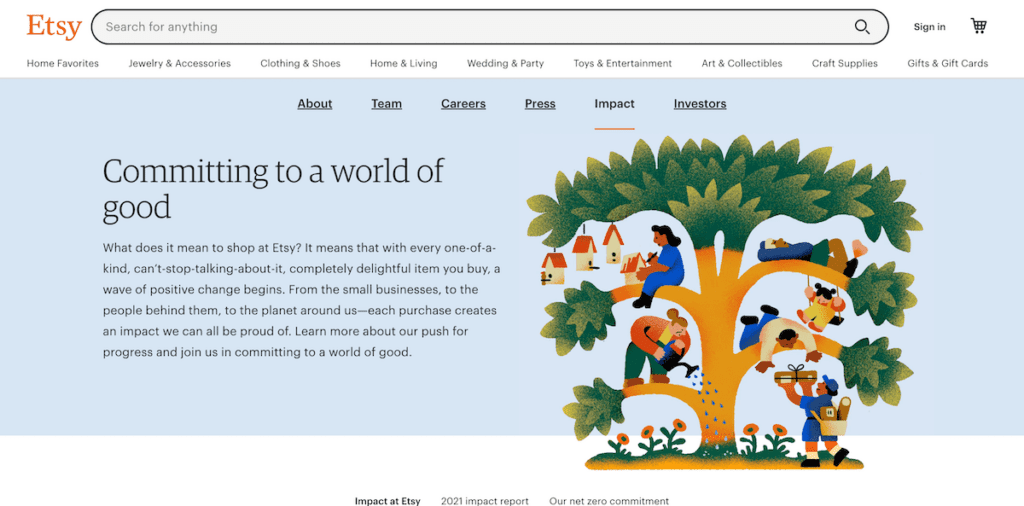
Etsy is an online marketplace for unique and handmade products. The company focuses on supporting independent sellers and artisans, promoting entrepreneurship, and providing economic opportunities.
Environmental sustainability is a key aspect, as Etsy continues taking steps to reduce its carbon footprint, promote responsible sourcing, and encourage eco-friendly practices.
Taking a significant step towards environmental responsibility, Etsy has become the first major shopping platform to fully offset all carbon emissions generated by shipping and packaging for every delivery.
However, their commitment extends beyond this accomplishment. Etsy has also set a target to achieve net zero emissions by 2030, demonstrating their unwavering determination to combat climate change and contribute to a greener world.
The RealReal
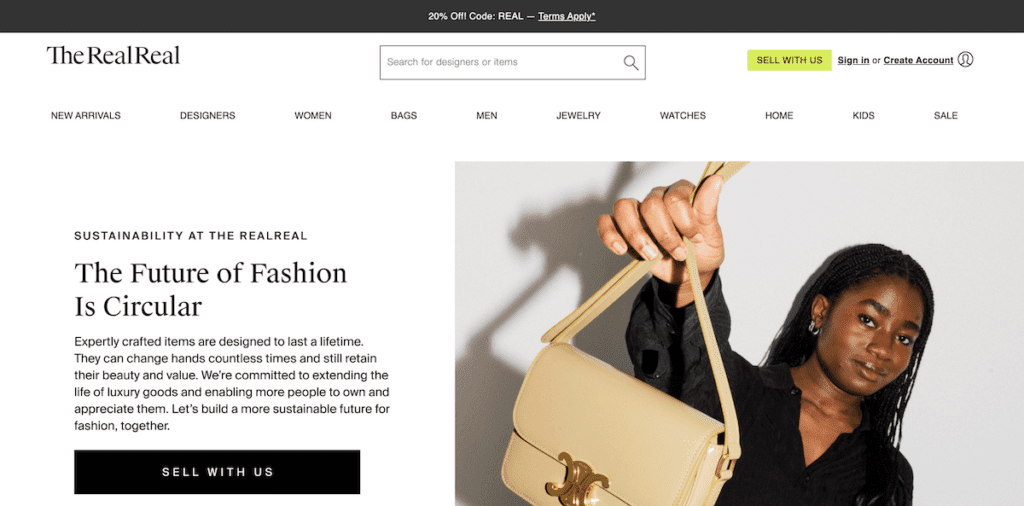
As a pioneering force in the fashion industry, The RealReal is actively leading the way towards a more sustainable future. The company stands as a founding member of the American Circular Textiles Group (ACT), an initiative aimed at uniting fashion’s stakeholders to drive substantial change through policy.
Their collective efforts focus on establishing the United States as a frontrunner in reducing textile waste and implementing circular fashion practices.
The RealReal collaborates with renowned luxury brands to expand the circular economy, setting new standards and encouraging shifts in consumer behavior.
To further enhance transparency and measure the positive impact of their resale operations, The RealReal has developed the TRR Sustainability Calculator.
This innovative tool, developed in partnership with the Ellen MacArthur Foundation, quantifies the greenhouse gas emissions, energy savings, and water conservation achieved through the resale of both women’s and men’s items.
Through these initiatives, The RealReal is actively contributing to a more sustainable and environmentally conscious fashion landscape.
Beyond Retro
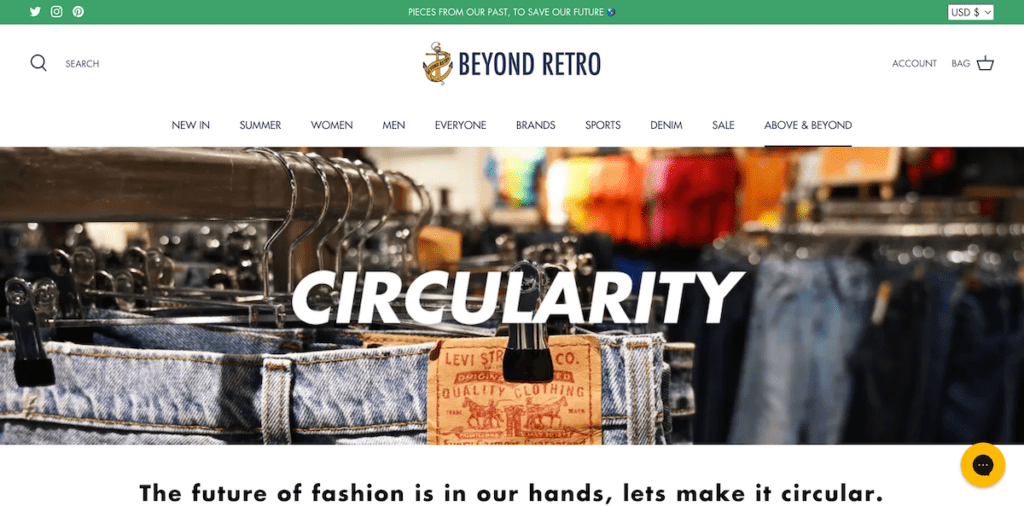
Beyond Retro is committed to shaping a sustainable future for fashion by promoting reuse, reducing waste, and encouraging responsible consumption. By choosing secondhand items, customers save significant resources, like the water needed to produce new jeans—equivalent to 36 bathtubs.
Since 2002, Beyond Retro has provided unique, pre-loved fashion, with a goal to reclaim and reuse 10 billion items. Their initiatives include the Beyond Retro Exchange, where customers can sell vintage pieces for up to 40% off future purchases, and the Clothes from Clothes line, made from reclaimed materials.
In collaboration with Bank & Vogue, Beyond Retro operates the largest re-manufacturing facility in India, recycling post-consumer textile waste to create new fashion, contributing to a circular economy.
Patagonia Worn Wear

Patagonia’s Worn Wear program is a pioneering initiative that empowers customers to buy, sell, and trade used Patagonia gear, promoting sustainable consumption and extending the lifecycle of high-quality outdoor apparel.
By encouraging the reuse of garments, the Worn Wear program aligns with Patagonia's core values of environmental stewardship, waste reduction, and responsible business practices.
Through Worn Wear, Patagonia aims to combat the environmental impact of fast fashion by reducing the demand for new production, conserving the resources required to manufacture new products, and keeping functional items out of landfills.
Customers can trade in their gently-used Patagonia clothing and gear in exchange for credit toward future purchases, fostering a circular economy where products are reused rather than discarded.
Each item traded through the Worn Wear program undergoes thorough inspection and refurbishment, ensuring the quality and durability for which Patagonia is known.
This commitment to longevity reflects the brand’s philosophy that well-made products should last for years, not just seasons. In addition to selling refurbished items at reduced prices, Patagonia also offers repair services, further reinforcing its commitment to minimizing waste.
Worn Wear also serves as an educational platform, encouraging consumers to adopt more sustainable habits and make informed purchasing decisions.
By showcasing the value of reusing and repairing clothing, the program highlights how small changes in consumer behavior can have a significant impact on reducing environmental footprints.
Ultimately, Patagonia's Worn Wear program reflects the brand's leadership in promoting a circular, sustainable fashion industry.
Rebag
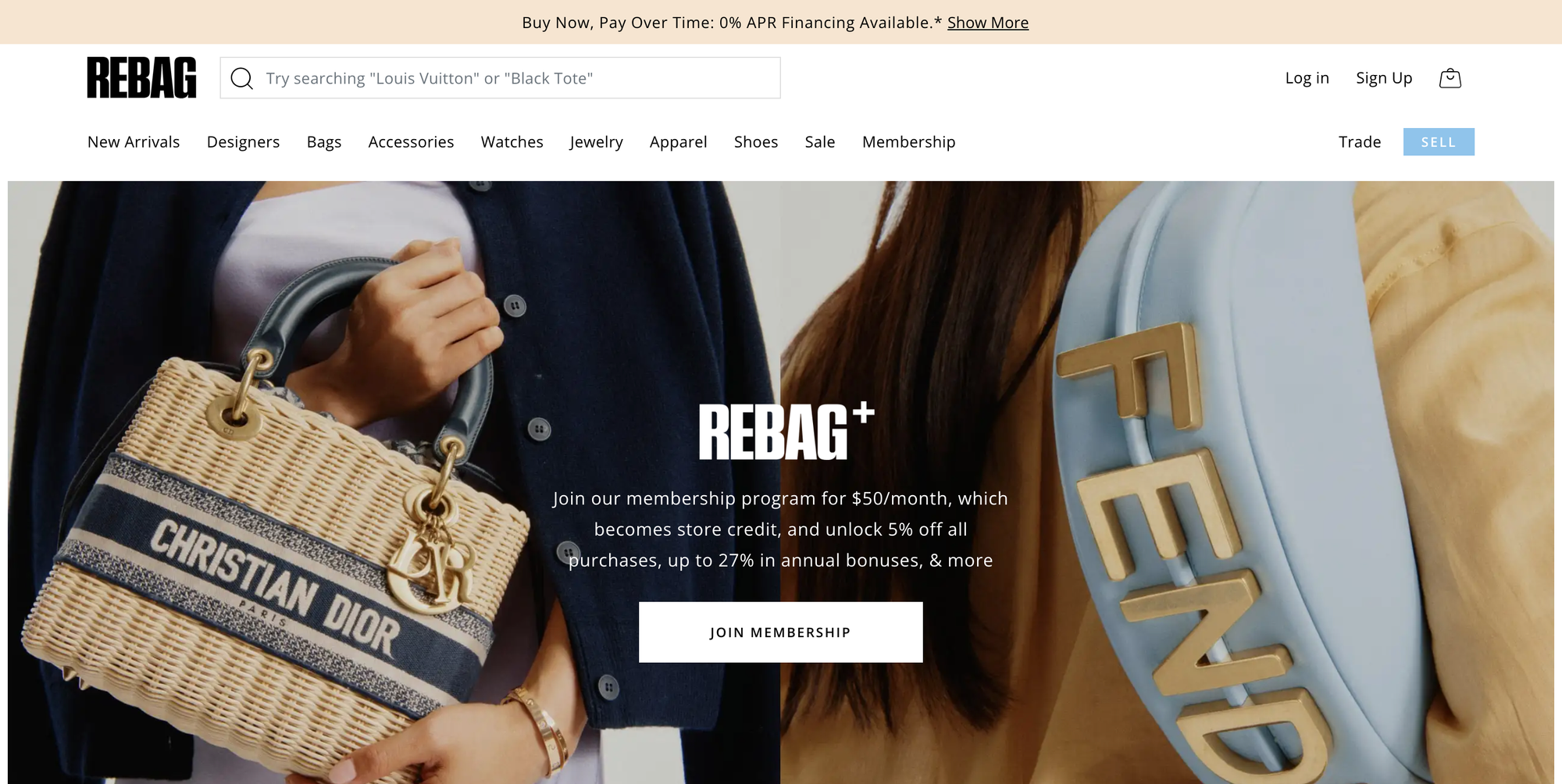
Rebag specializes in the resale of luxury handbags and accessories, offering a curated collection of authenticated designer pieces from top brands such as Chanel, Louis Vuitton, and Hermès.
By providing consumers with access to high-quality, pre-owned items, Rebag allows customers to invest in timeless luxury without the environmental impact associated with new production.
\Their strict authentication process ensures that every item meets the highest standards of quality and authenticity, giving buyers confidence in the value of their purchases.
This model not only provides a more accessible way to own luxury goods but also promotes mindful consumption in the fashion industry.
Rebag’s business model is rooted in sustainability, as it actively contributes to the circular economy by keeping luxury products in circulation longer.
By extending the lifespan of these meticulously crafted items, the company reduces the need for new materials, which helps lower the environmental burden associated with manufacturing and resource extraction.
The resale market Rebag fosters encourages consumers to see luxury fashion as an investment, where items retain their value over time and can be resold or reused.
This approach helps combat the throwaway culture of fast fashion, aligning with growing consumer demand for more environmentally responsible shopping choices.
eBay
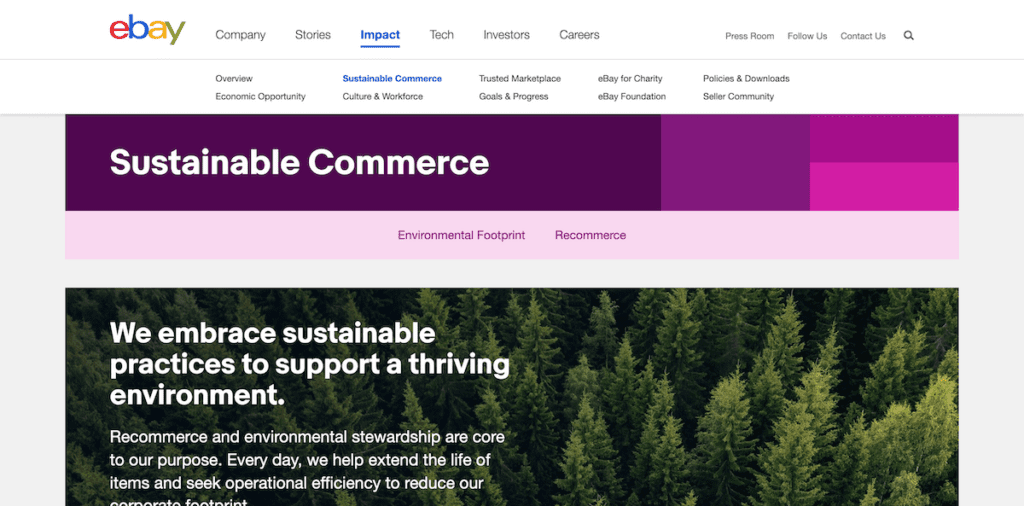
eBay is committed to sustainable commerce and making a positive impact on the environment. The company recognizes the importance of responsible business practices and has implemented various initiatives to promote sustainability.
Through their website, eBay highlights their efforts in reducing waste, supporting renewable energy, and enabling circular economy principles.
eBay aims to minimize its carbon footprint by operating data centers powered by renewable energy sources.
They have made significant investments in solar and wind energy, allowing their operations to be more environmentally friendly. By prioritizing renewable energy, eBay actively contributes to the global transition towards clean and sustainable power sources.
In addition, eBay focuses on waste reduction through their marketplace. They facilitate the buying and selling of pre-owned items, extending their lifespan and diverting them from landfills.
This approach encourages a circular economy, where products are reused and resold rather than discarded. By enabling the reuse of goods, eBay promotes sustainable consumption and reduces the demand for new production.
The company also emphasizes the importance of responsible packaging. eBay encourages sellers to use eco-friendly packaging materials and provides guidelines for sustainable shipping practices.
These efforts help minimize waste generated from packaging materials and contribute to a more sustainable supply chain.








